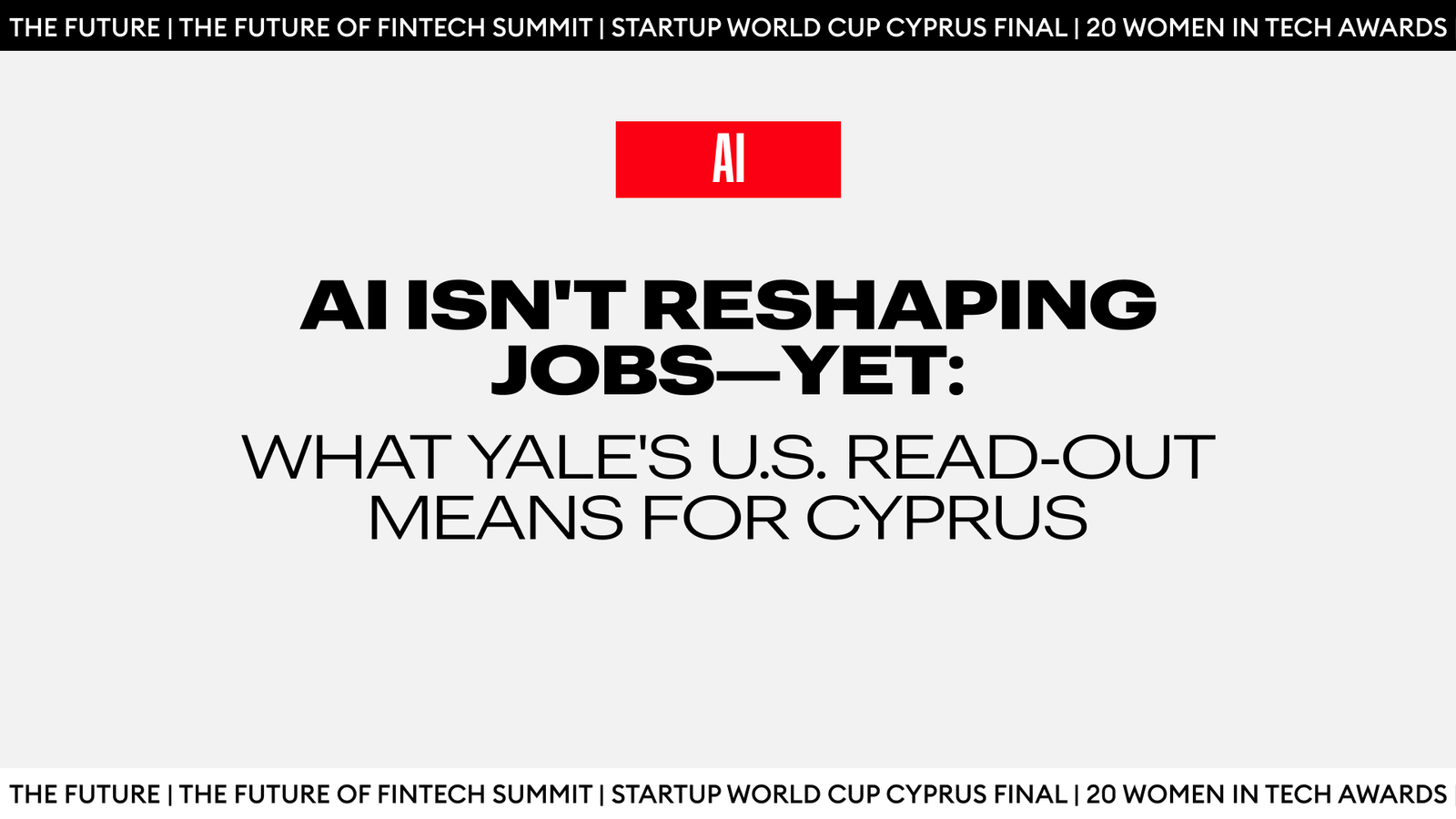Despite a year of widespread panic, a new study by the Yale Budget Lab finds no large-scale labor disruptions in the United States, even 33 months after the debut of ChatGPT. According to the authors, the technology hasn’t displaced American workers any more dramatically than earlier innovations of the last century. Cyprus’s economy is showing the same stability, with lower AI adoption, a service-dominated economy, and youth over-qualification all suggesting a stronger influence on how (and when) generative AI will show up in the data.
The Bigger Picture
Yale University’s Budget Lab has built a monthly index tracking how the U.S. occupational mix, that is, the distribution of workers across jobs, running from November 2022 through July 2025 (latest CPS at publication). Their conclusion? There is no discernible, aggregate disruption so far. The most recent changes are modest and largely consistent with past technology waves, such as the introduction of PCs and the early internet. What is even more revealing is that these changes were already underway before the launch of ChatGPT.
Follow THE FUTURE on LinkedIn, Facebook, Instagram, X and Telegram
This study covers the United States only. However, we can use EU and Cyprus statistics to draw parallels between the two economies, though being fully transparent that any claim should be taken with a grain of salt. For instance, consider these data points:
- According to data from the December 2024 Economic Bulletin of the Central Bank of Cyprus, in the first nine months of 2024, the unemployment rate in Cyprus was at 5%, compared to 5.9% in the same period of 2023.
- CYSTAT ICT in Enterprises 2024 report found that 7.9% of enterprises in Cyprus claimed to use AI technologies in 2024 (this is up from 4.7% in 2023), with 34.9% of large enterprises, 14.3% medium, and 6.3% small.
- A January 2025 report by the European Commission stated that in 2024, 13.% of enterprises in the EU with 10 or more employees used artificial intelligence (AI) technologies.
- Eurostat article, “Use of artificial intelligence in enterprises,” published in 2025, shows AI adoption in the Accommodation and Food sector is only 6.09% (and all sectors outside Internet Technologies and Professional/Scientific/Technical are below 16%).
Cyprus shows a similar pattern of stability to the US mapping by Budget Lab. There’s no post-2022 break in headline labor indicators, AI adoption sits below the EU average, and the tourism-heavy economy means less immediate exposure to large language models. Factor in Cyprus’s high over-qualification rates (which can move youth employment metrics for reasons unrelated to AI), and the conclusion is watch the same white-collar service sectors Yale tracks, but don’t assume AI is driving any displacement until the usage data improve.
What Yale set out to test
The research team posed two questions:
- Has the pace of U.S. labor-market change since ChatGPT’s release in November 2022 differed from earlier technology waves, such as PCs in the 1980s and the internet in the late 1990s?
- Is there any economy-wide employment effect so far?
The team uses a monthly ‘dissimilarity’ read on the occupational mix, built from CPS microdata and compared with those benchmarks, and reports the results as 12-month averages. A percentage-point difference is simply how many workers would have to be in different occupations to match a baseline; it describes change but does not explain cause. The authors do state that this will also pick up non-AI dynamics; for example, if recent graduates are hired less and tend to be in different occupations than older workers, the index will show change even if AI is not the reason.
The authors also add two context checks:
- pre-trend charts indicating much of the recent change was already underway in 2021, before ChatGPT
- a longer-run reference showing job-mix churn was faster in the 1940s and 1950s
They then complement the index with two AI lenses. The first is a relative exposure cut using OpenAI’s GPT-4 Beta scores, where the worker shares in low, middle, and high exposure buckets are about 29 percent, 46 percent, and 18 percent, and remain stable. The second is a usage read using Anthropic’s Claude to see whether occupations with higher measured use are growing or shrinking. After setting out the measure and its limits, the report turns to findings.
What Yale found in the U.S.
No aggregate disruption: Across all indicators, there’s no economy-wide AI shock in the U.S. 33 months after ChatGPT’s launch.
Historical context matters: The current change is modest, around 1% above the late-1990s internet period, and much of the increase began in 2021.
Sectors: Larger movements appear in Information, Financial Activities, and Professional & Business Services, but most trends in these sectors predate ChatGPT. Looking over more years, the Information sector was already changing for other reasons. It follows a long pattern, not a sudden effect from one AI tool.
Exposure doesn’t equal usage: In Yale’s main (relative) cut, the share of workers in low/middle/high exposure occupations has stayed generally stable at 29% / 46% / 18% since ChatGPT’s launch. There is only a weak correlation between OpenAI’s exposure scores and Anthropic’s Claude usage data. Using Anthropic’s Claude data, the share of workers in occupations where over 50% of observed usage indicates automation/augmentation is 70% / 11% respectively when excluding missing tasks, but only 3% / 0%whentreating missing as zero. Yet, in both cases, the trend is flat. Usage is heavily preferential toward certain providers and concentrated in computer/mathematical and arts/media occupations. Any conclusions about actual adoption levels depend heavily on how you treat missing usage data.
High-exposure group is tiny: Using absolute exposure thresholds (low: <0.4 / medium: 0.4–0.8 / high: >0.8), workers’ shares break down to 45% / 45% / 2%, and these proportions have been flat since late 2022. The group with the highest exposure is very small and hasn’t grown.
Early-career effects remain ambiguous: There’s a slight rise in dissimilarity between recent and older graduates, but it sits within a historically typical range and is hard to interpret given the Current Population Survey’s small sample sizes and a generally slower labor market.
The authors conclude that any changes should not be immediately attributed to AU at the economy level. They will update the CPS-based occupational-mix indexes each month and add new AI-usage data when available.
Cyprus takeaways
First, scope. The Yale work is focused on the US context; any EU or Cyprus comparison is based on an analysis of the available public statistics.
Exposure isn’t usage. The authors warn that exposure to AI is not the same as actually using it, which is reflected in their data. In Europe, only about 13.5% of enterprises used AI in 2024. In Cyprus, just 7.9% of firms used AI, with adoption concentrated in large enterprises and far lower among SMEs. If the U.S. shows no economy-wide disruption at higher levels of adoption, it is reasonable to expect slower, less visible effects in Cyprus’ aggregate numbers for now.
Sector-specific. Yale’s U.S. movements cluster in Information, Financial, and Professional/Scientific/Technical services. Cyprus participates in the same sectors, but a large share of local employment is in accommodation and food. Across the EU, that sector shows roughly 6% AI use, which is among the lowest by industry. That mix helps explain why near-term, broad LLM-related shifts are unlikely to show up first in Cyprus’ headline statistics even if specific white-collar niches begin to change.
Youth and skills. Cyprus has one of the highest over-qualification rates in the EU, close to 28% in 2024. The Yale index captures change in who works where, not why. A structural mismatch, like over-qualification, can move outcomes for young graduates without AI being the driver.
Standards of evidence. Yale’s usage lens relies on one provider’s data, and the authors find only a weak link between exposure and usage. They call for privacy-safe, multi-provider usage data before drawing firm conclusions. Cyprus has even less model-agnostic usage evidence. Until those data exist, economy-wide claims about AI’s impact on jobs in Cyprus should be treated as unproven.
What to keep an eye on in Cyprus
In Cyprus, the first signs, if they come, will show up inside white-collar services. So, information and communication, professional and scientific work, finance, and business services. The suggestion is to track usage, not headlines. That means internal deployments of genAI tools, procurement or budget lines for AI software, and job ads that ask for LLM workflows or prompt-engineering skills.
The second indicator to watch is SMEs. Adoption there is still low, so any narrowing of the gap with large companies would matter for diffusion beyond a few big employers.
The third is early-career outcomes. Cyprus has high over-qualification, so watch whether digital roles expand in ways that absorb recent graduates. If the mismatch persists, changes in the occupational mix for young workers can appear even when AI is not the cause.













